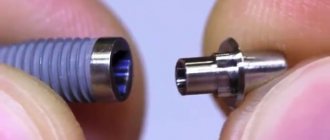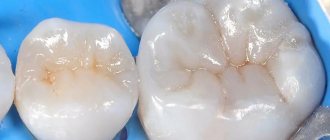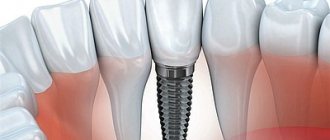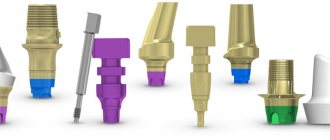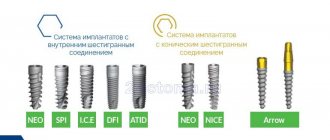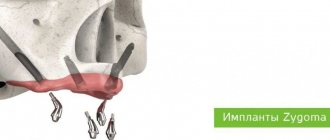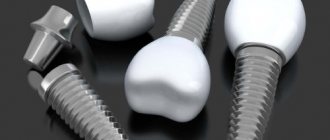In addition to the plant in Israel, the company has production plants in France and Germany. The abbreviation MIS itself stands for Medical Implant System. Behind such a simple name lies a completely successful project. By the time of its twentieth anniversary, MIS managed to reach a high production level and produces more than one and a half million implants per year. This is a very good indicator, taking into account the fact that most market leaders began their activity back in the 60s and 70s of the last century. Why did “Mis” dental implants become such a popular system in a short time? The answer is simple: they have an excellent price-quality ratio plus a fairly wide range of products for various clinical cases.
MIS implants - catalog of solutions for all cases
The official MIS website says that MIS Liment implants and orthopedic components are produced at a factory in Israel. Each implant produced by "Mis" (Israel) undergoes sandblasting and acid etching, which makes its surface similar in structure to natural bone tissue. Many MIS implants have a combined shape and an unusual thread pitch with special spiral-shaped tubules in the apical zone (at the tip). This concept is designed to provide primary stability during installation and optimal osseointegration.
MIS C1
The standard MIS implant is conical with a hexagonal connection and is designed to closely resemble the root of a natural tooth. Typically used for classic two-stage implantation, however, the manufacturer states that the C1 line can also be used with immediate loading (when a dental implant and temporary crown are installed during one visit).
MIS V3
One of the company's advanced developments. The implants of this series have a triangular coronal shape, which helps ensure the stability of the artificial root during installation and correctly distribute the pressure on the bone tissue. The design also allows for the preservation of the volume of soft tissue above the platform, which is why the installation of the MIS V3 implant often occurs for aesthetic restorations in the smile area. The diameter of the V3 series implants ranges from 3.30 to 5 millimeters, and the length - from 8 to 16 millimeters.
MIS SEVEN
These are self-tapping implants with double threads, the thickness of which increases from the tip to the neck. A universal system that is suitable for different types of bone, and is also installed during bone grafting. The shortest implants in this series are 6 millimeters long.
MIS M4
This series is a screw implant of a combined cylindrical-conical shape. Used for both two-stage and one-stage implantation techniques.
MIS UNO
A one-piece design that is designed specifically to replace missing incisors of the lower and upper jaws. Implants from this line are often used as a support for bridges.
MIS Link
This is a line of MIS orthodontic implants, which are not used in classical implantation, but are designed to perform a supporting function during orthodontic treatment.
Bottom Line: Key Differences Between MIS and ERP
To summarize, the following differences can be distinguished.
First of all, as already indicated at the very beginning, MIS is a more general concept of information, or, more precisely, a whole class of management systems, a special case of which is ERP as information specifically about resources. The consequence of this is a certain difference in the specifics of interaction with data.
The task of MIS is primarily to work with reporting, that is, collecting, storing and processing information from certain sources. ERP, on the other hand, pursues the goal of automating business processes and accounting that are associated with managing company resources. In addition, ERP has functions for tracking the current state of the business, analyzing and making forecasts for future activities and development.
In what clinical situations would MIS be suitable?
As the manufacturer of MIS implants indicates on its official website, implant surgeons can use them for:
- dental defects,
- complete absence of teeth,
- impossibility of using a removable prosthesis.
MIS implants are suitable for restoring teeth in the upper and lower jaw, and both classical implantation is possible in two stages (installation of an artificial root, and then, after its engraftment, loading with prostheses), and one-stage - after installing the implant, a temporary prosthesis is immediately fixed on it . To perform one-stage implantation using MIS, it is necessary to achieve good primary stability and acceptable occlusion.
Narrow implants (with a diameter of 3.3 mm) can only be used in those areas of the jaws where there is a partial absence of anterior and (or) lateral incisors, i.e. narrow implants are designed to restore the smile area.
How are implants installed?
The range includes universal models suitable for both classical and one-stage technology, when the implant is implanted into the hole immediately after tooth extraction. Typically installation is done in the standard way:
- the dentist makes a neat incision on the gum, forms a bed for the implant in the bone,
- Next, an artificial root is fixed, and a special plug is placed on top. The gum is tightly sutured,
- after the structure has healed (4-6 months), the doctor removes the plug and installs the abutment. It is he who becomes the connecting link between the implant and the crown.
The one-stage installation method assumes that the crown is fixed immediately after implantation of the artificial root. True, it is better not to use this particular brand for such solutions, because the models do not have increased fixation force immediately after installation - if they are overloaded, there may be complications. Therefore, MIS is still more suitable for delayed loading, when dentures are placed only after the implants have completely fused with the jaw bone.
Orthopedic briefcase. Crowns for MIS implants
Modern implant companies must also have a wide range of abutments to provide decent prosthetics in a wide variety of clinical cases. The MIS company works quite productively in this direction and has a very wide selection of abutments with both cement and screw fixation. The range includes standard, spherical, as well as temporary abutments for attaching crowns to MIS implants during healing. Depending on the diameter of the implant itself, three abutment platforms of different widths are used.
DSM (Dual Stability Mechanism) principle:
The DSM principle (double stabilization mechanism) is the latest unique method developed by MIS Implants specialists together with other doctors, which consists of creating an ideal environment for accelerated bone tissue growth and ensures a rapid onset of osseointegration. Thanks to the DSM principle, it was possible to achieve the smallest decrease in implant stability in the period 3-5 weeks after installation.
Reviews from specialists about MIS implants
Many specialists from clinics where MIS implants are installed in Moscow call them the best budget system for dental implantation, especially since even an economy class clinic that does not have great financial resources can buy MIS implants. This status, of course, cannot be considered official, but the company is interested in doctors around the world giving preference to its implants and using them in their clinical practice. Good survival rate (exceeding 98%), a wide choice of prosthetics and ease of use are the main advantages of MIS for clinicians. In general, reviews of Mis implants from dentists are positive. However, there are doctors who are skeptical about this manufacturer, as well as about budget systems in general, since such implants do not allow achieving ideal aesthetics and are not designed to work in complex clinical cases.
Be that as it may, even though MIS is not a pioneer in the industry and a developer of advanced solutions, it rightfully occupies its place in the market. In addition, the high quality indicators of MIS are confirmed by a number of certificates. In particular, an independent study by POSEIDO, which examined implants from the most famous manufacturers, confirmed that the Mis implant (Israel) has one of the cleanest and most reliable surfaces.
Advantages and Disadvantages of ERP
The advantages of ERP systems compared to similar software solutions are considered to be:
- Simplified reporting . ERP solutions usually have a built-in template for creating reports, or employees can create custom reports.
- Planning upgrade : the software has the capabilities to prepare the necessary stocks of materials, raw materials, and control the fullness of warehouse premises.
- Increased efficiency . Like MIS, ERP software reduces repetitive manual processes so the team can focus on more important tasks.
- Data protection . These systems have several tools for protecting data: firstly, different levels of access, secondly, the data is stored in one database and not in different sources, which simplifies the protection of the system, and thirdly, ERPs create backup copies of important data.
- Improved business processes . Resource planning systems provide timely access to data.
- Improved supply chain management . The improvements that ERP can offer include minimizing order processing times, more on-time deliveries, and automating much of your workflow.
- Scalability . If a company plans to open a new branch, expand its client base, or launch a new project, then it is almost always possible to scale the ERP system for different sizes of the organization and flexibly adjust it to specific needs.
- Unified network . The platform controls all departments simultaneously. The performance of the company will not decrease even if all employees start working on one file.
- Data control . The system contains, controls and helps manage information regarding company personnel, suppliers and clients.
Disadvantages of ERP systems:
- ERP system cost . Most of these systems are distributed by subscription, which involves paying for both the functions that are needed and all the others. In addition, if you don't make the payment, then all or almost all the ERP functions will be blocked, which will create a lot of problems.
- Complexity . Commissioning requires specific skills, which immediately leads management to find the necessary personnel and introduce an additional cost item into the business plan.
- High requirements for working equipment . Without reliable servers and reliable storage programs, it is pointless to count on high-quality system operation.
- Need for additional data protection . Information located in the cloud is subject, like any other, to theft, substitution and banal damage. Out-of-the-box options are not much more reliable: if an attacker is on the organization’s premises, he can still hack systems, which necessitates the need for qualified protection against hacker attacks.
- Energy dependence . This is a problem with all such systems. Any failure in the energy supply and energy consumption system in the future may lead to data loss or a rollback to previous levels.
Features of implementation
The process of implementing ERP class systems is far from a simple process. First comes the integration of the most important blocks, which comprise the basis of the company’s activities. As a rule, these are parts of the architecture such as the platform (a base with minimal capabilities, that is, the environment) and “money control”, where the database is stored, methods for storing and processing arrays are taken into account, “working” tools are located, as well as software for working with them. Next, the rest are built in, which relate to individual units that are not so significant.
Key advantages of MIS implants (Israel):
- good quality/price ratio;
- a good selection of “Mis” dental implants and related orthopedic structures;
- relatively short healing period: the MIS implant (Israel) takes 8 to 10 weeks on average, which is a very decent indicator for an economy class system;
- 5 year warranty on installed structure.
How long does the system last?
As many experts believe, full compliance with the recommendations of the treating dentist can extend the life of the implant for life. More accurate prediction becomes possible one and a half to two years after prosthetics. So, if during this period the process of adaptation to the chewing load was successful, and no problems arose with the implant, as well as the prosthesis supported by it, it means that the treatment performed is correct and of high quality, and therefore the device will serve for a very long time.
How much do MIS implants cost?
The price of MIS implants is approximately on the same level as Alpha Bio and Korean implants. In some clinics this system will cost a little more, but in general the cost variation is insignificant. In Moscow, the price of MIS dental implants (Israel) averages 17,000 - 20,000 rubles, which is almost two times less than treatment with implants from top manufacturers. Prosthetics with a metal-ceramic crown will cost approximately 40,000 rubles. At the same time, you should not think that you are overpaying only for the brand and that there are no fundamental differences between luxury and economy class implants at all. The brand, of course, greatly influences the cost of the implant, but it is naive to believe that you are paying such large sums just for the name. Top systems offer enormous possibilities for both the patient and the clinician, and also allow achieving ideal aesthetics even in difficult cases.
Why choose MIS implants
The MIS company is located in Israel and is considered one of the leaders in the field of implantology throughout the world with an annual batch of equipment of 1.5 million dental devices. Israeli MIS implants are sold in 72 countries through a highly organized network of official distributors. They are successfully used by tens of thousands of specialists and have become the choice of millions of patients who have decided to entrust the restoration of their health to this particular company.
It is also important that MIS implants make it possible to preserve your smile for life. With their help, you can restore previously lost teeth, while completely repeating their external and functional qualities. Therefore, choosing this solution guarantees complete relief from all the inconveniences that are possible when wearing dentures or the absence of natural teeth.
Abutments
MIS abutments represent a reliable link between the denture and the implant itself. The abutment is finally installed after successful completion of the process of osseointegration and implant healing.
The types of abutments in the MIS series include the following:
- narrow orthopedic working platform;
- classic orthopedic platform;
- wide platform;
- orthopedic parts for multi-component composite abutments.
Multi-component abutments are used to carry out work with removable structures. The impression is taken using special transfers and similar installations of a multi-component abutment.
Manual Information Systems VS Computerized Information Systems (MIS)
Data is the lifeblood of any business entity. Everyone in an organization needs information to make decisions. An information system is an organized way of recording, storing data, and retrieving information.
In this section we will look at manual information systems and computerized information systems.
Manual information system
A manual information system does not use computer devices. Recording, storing and retrieving data is done manually by the people responsible for the information system.
The following are the main components of a manual information system.
- People - people are the recipients of the information system
- Business procedures are measures that define the rules for data processing, storage, analysis and information production.
- Data is recorded daily transactions
- A storage system is an organized way of storing information
- Reports - Reports are generated after manually analyzing and compiling data from the storage system.
The following diagram illustrates the operation of a typical manual information system
SEVEN implant packaging
The double packaging system ensures the sterility and integrity of the implants. The internal packaging of the implant is specially designed to hold it in gloves and make it easier to remove the implant during surgery.
The outer bulb of each implant is labeled with a color-coded platform and the diameter and length of the implant.
Cover screws* and healing abutments
Narrow orthopedic platform
| MC1-00330 | Height range: 2, 3, 4, 6, 8 mm MH-N2330 MH-N3330 MH-N4330 MH-N6330 MH-N8330 | Height range: 2, 3, 4, 5, 6 mm MH-52330 MH-53330 MH-54330 MH-55330 MH-56330 |
Standard orthopedic platform
| MC1-00375 | Height range: 3, 4, 5, 6 mm MH-03375 MH-04375 MH-05375 MH-06375 | Height range: 3, 4, 5, 6 mm MH-53375 MH-54375 MH-55375 MH-56375 |
Wide orthopedic platform
| MC1-00470 | Height range: 3, 4, 5 mm MH-W3500 MH-W4500 MH-W5500 | Height range: 3, 4, 5 mm MH-W3630 MH-W4630 MH-W5630 |
** Screws - plugs are colored according to the color coding of the platforms
Installation cost
The cost of implants can be attributed to the high price, but despite this, many experts recommend this type of osseointegration. The average cost of a turnkey installation varies from 32,000 to 40,000 rubles.
The price is based on the dollar exchange rate, region or country where the dental restoration procedure is performed. The price includes labor, initial and subsequent inspections, installation.
The prices in the table are given as an example, since the final cost is determined by the complexity of the clinical situation, exchange rate and other economic factors.
| Model | Installation and design, rub. | Implant opening, rub. | Installation of the gum former, rub. | Installation of an implant with prosthetics, rub. | Implant removal, rub. |
| MIS Lance | 19000 | 2000 | 1500 | 33000 | 2200 |
| MIS C1 | 21000 | 1800 | 1800 | 37000 | 1900 |
| MIS Seven | 22500 | 1900 | 1500 | 35500 | 1700 |
| MIS M4 | 23000 | 1800 | 1500 | 35000 | 1800 |
| MIS UNO | 19000 | 1800 | 1600 | 34200 | 1900 |
| Orthodontic | 22500 | 2000 | 2000 | 37000 | 2300 |
| Provisional | 18500 | 2000 | 2000 | 34000 | 2000 |
The video presents the stages of safe installation of systems from an Israeli company.


